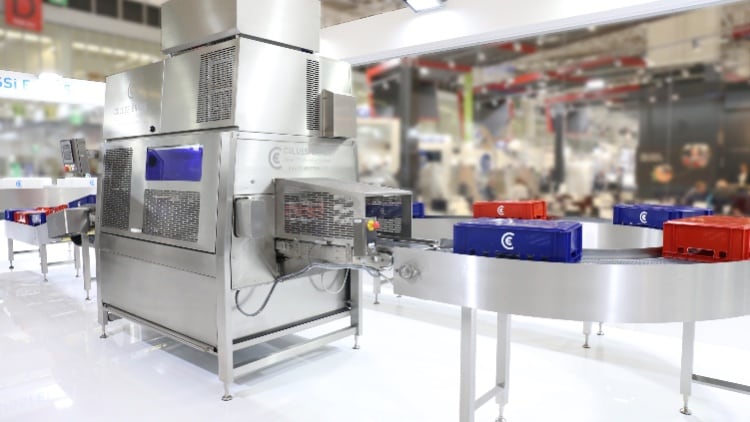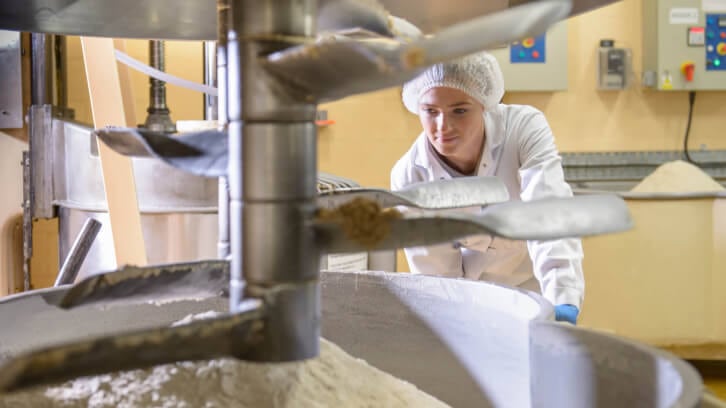One of the common themes in the 90-min session was the championing of science and data and how these areas can influence the safety and robustness of our food supply.
In the opening address, Julie Pierce, director of information & science at the Food Standards Agency (FSA) highlighted the changes our sector has seen and the response this has mandated.
“Our food system is no longer static, quite the opposite – suffering shocks and seeing long term shifts,” she said.
Being able to predict and react to these events is enabled by data extraction, but currently businesses are doing this independently, with one up, one down links. We need to expand the picture, as today’s climate demands we understand the end-to-end food system.
“We need to be able to join up more of the links and make that data available to others,” she stated. This includes food business operators, as well as government regulators and other stakeholders that play various roles in the food system.
“The FSA is very aware of the large amount of data in the food system. We are keen to reuse it whenever possible and only create more where necessary.”
One of the answers is the Food Data Transparency Partnership (FDTP). This is a cross government, multiyear partnership with the food industry which aims to publish data on topics of sustainability, starting with greenhouse gases and nutrition.
“The Food Data Transparency Partnership is an initiative we [FSA] is working on with Defra, Department of Health and Social Care, and industry,” Pierce informed.
The FDTP and ironing out the kinks
The FSA together with GS1 chairs the Data Working Group, which is focused on the practical delivery of the FDTP goals.
“We are grappling with the mechanics of thinking about how data is captured and then flows through the system,” said Pierce on how the focus of the meetings.
Questions such as how data will move between suppliers, trust in the metrics and a level playing field are all areas the Working Group are considering.
While businesses will have established systems for commercial data sharing, they’re now being pushed to share data on these new metrics, so governance and interoperability are very important.
The outcome is not likely to be a big, centralised IT system, but consistency and coherence will play a big role, Pierce explained.
“We might need a standard to enforce that.”
Lack of data skills and expertise also present an issue, but Pierce said overall she is optimistic: “I can see a real drive to gain greater insight into the food system.”
She continued: “I see technology solutions that are more sophisticated and reasonably priced than before and hence available to more players. I see the connections being made across different domains.”
While she said that the food and drink sector is unique and special as an industry, she believes the way data and technology can be deployed can be inspired by other sectors that have done it well.
Greenwashing is food fraud
While the FDTP will be making data on areas such as sustainability more widely available and harmonious between sector players, new legislation around green claims is also looming.
One example is the upcoming EU Anti-Deforestation Regulation (EUDR), mandating companies trading with EU members states/within the bloc to provide evidence that their products do not contribute to deforestation.
In his talk, David Psomiadis CEO of Imprint Analytics, emphasised the rising cases of greenwashing and the ways in which new regulation fighting against it could present challenges for food producers.
“We’re hearing more and more about the risks that derive from supply chains related to deforestation, forced labour, child labour or even environmental damage,” he said as he showed several clippings from mainstream media headlines.
“The topics related to green claims reflect the fraud risk in an area we call greenwashing.
“Greenwashing is a crime because it’s a type of food fraud.”
He explained common motives for this type of fraudulent activity, including how easy it is to do as a result of a globalised supply chain and the likelihood of being caught (i.e. being much lower).
New legislative change aims to help prevent this; however, it will require fresh thinking. This is because food producers will essentially become liable for everything that happens before the ingredients/raw materials are transferred to their facility.
“That creates really a risk because the control of that is really complicated. And then understanding of the risks that might derive from very different parts of the world or global businesses,” said Psomiadis.
There are a range of analytical tools such as chemical fingerprinting which can be deployed to help determine origin of a commodity, for example. But in order to mitigate against such a complicated challenge, it will also come down to knowing your supply chain – and this will rely on collaboration.
Collaboration is key to figuring out solutions to food safety challenges
One company which is doing great work in the area of de-risking its supply chain through collaboration is Mars Inc.
“The world we want tomorrow starts with the business we do today,” said Boris Bolschikov, head of food safety research and the Global Food Safety Center at Mars Incorporated.
The Global Food Safety Center which opened in 2015 focuses on three key areas: microbial risk management, mycotoxin risk management and food integrity management.
Climate change is one of the biggest issues driving food safety issues such as mycotoxins. Mycotoxins are toxic compounds naturally produced by certain types of moulds (fungi). They can grow on widely used foodstuffs such as maize, wheat and peanuts, as well as eggs and milk if consumed by animals.
Among other things, Mars has been working with tools such as genomics to address the safety issues presented by mycotoxins such as aflatoxins, which pose a serious threat to human and animal health.
The solutions which Mars is investigating will help to determine the source of contamination and detect the presence of such toxins.
These are not under gatekeeping either, the centre recognises that food safety is a non-compete issue for the sector. The centre acts as hub for research and training, sharing its findings with those who are interested. In other words, the work is done for the industry and for the better of society.
“We believe that no one entity can address food safety challenges alone,” said Bolschikov.
“One of the greatest examples of partnerships we have is with the World Food Programme. We have worked together since 2015 to ensure vulnerable communities around the world have access to safe, nutritious and quality food.”
As part of this Mars is helping to train smallholder farmers who do not have access to training to help improve supply chain resilience and safety.
Food safety and cleaning options
While many of the speakers focused on the food safety challenges before the factory, our expert speaker from Unibloc Hygiene Technologies, looked at the issues inside the facility walls.
Poor hygiene and sanitation can be detrimental to a business just as much as toxins and adulteration that find their way into your supply chain earlier on. Without proper consideration of cleaning, a business can be faced with the prospect of food recalls which can be harmful to consumers and profit margins.
Cleaning in place vs clean out of place
Regional sales manager for UK & Ireland, Ross Came, gave a comprehensive overview of sanitation options you have when it comes to pumps, looking at the pros and cons of clean in place (CIP) and clean out of place (COP) specifically.
CIP pumps are designed to clean equipment and piping without disassembly, using automated cleaning cycles and specialised cleaning solutions. Whereas COP pumps require disassembly of equipment and components to be cleaned separately in dedicated areas or facilities.
Depending on your type of business needs, each has its own set of advantages and disadvantages. He whittled this down to the following:
COP – advantages
- You can use friction – manual cleaning physically removes the soil
- You can remove all the parts and get into the crevices which are hard to reach
- Lower capital expense, so don’t have to invest in new pieces of equipment
- No need for a separate pump, CIP tank or piping
COP – disadvantages
- Potential cross contamination from workers more likely
- Higher labour costs
- Training is required
- Safety– if you are handling tools, there is a chance you may injure yourself if twist in a certain way for example
- More likely to damage the equipment
CIP – advantages
- Automated cleaning
- No removal of plumbing
- Reduced labour cost
- Faster operation
- Reduced equipment damage from disassembly
CIP – disadvantages
- Higher capital expense
- Usually needs a separate pump, CIP tank, piping
- Nature of cleaning product – often hazardous
- Drainability required to avoid cleaning liquid from becoming stuck
The right approach for your business will depend on factors such as equipment complexity, cleaning requirements, production schedules and regulatory requirements which engineers must consider carefully for optimal manufacturing processes.
The Food Safety Briefing 2023 was sponsored by headliners Unibloc and supported by Munters, QAD Redzone and Thermo Fisher Scientific. You can watch the whole thing back on-demand for free here.





